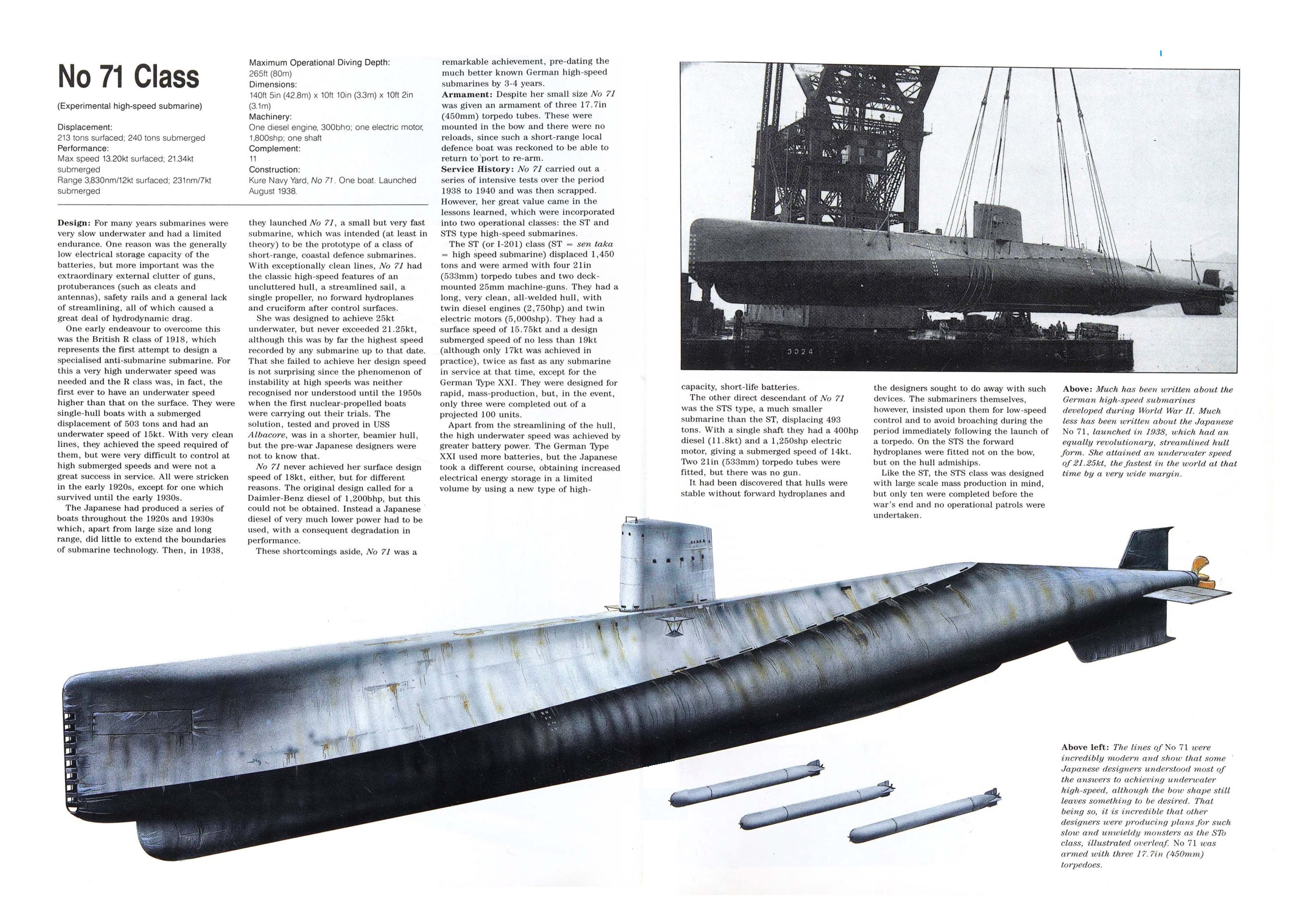
Type ST Sentaka type submarine
General arrangements and sections of the type I 201 class submarine.
I 201 Japanese submarine class. These Type ST submarines were designed after exhaustive tests and trials with the high underwater speed experimental submarine No 71. The hull was fully welded and very carefully streamlined; no gun or other deck obstruction was allowed which might impair the under- water performance. Even the 25-mm (1-in) mount retracted into a streamlined housing in the conning tower. The whole design concentrated on underwater performance, and new electric motors were installed giving the vessels an underwater speed of 19 knots. The high-capacity batteries carried sufficient energy to give the vessels an underwater radius of action of 135 nautical miles at 3 knots. The maximum submerged depth achieved by the submarines was 110m (360 ft), the greatest depth achieved by a Japanese submarine. In many respects the vessels resembled the German Type XXI and when completed they were the first operational GUPPY type submarine in the world. Specially designed lightweight MAN diesels were used for surface propulsion, to keep displacement low. Only small bunkerage was provided, and the surfaced radius of action was only 5800 nautical miles with an endurance of 25 days.
Construction employed full mass-production techniques, with the submarines assembled in section in factories, the completed sections being welded together on the slip. The whole operation from start to finish took on average only ten months. A total of 23 units were ordered from the Kure navy yard under the 1943 Programme, construction commencing in March 1944. A further 76 units were projected under the 1944 Programme, but the progress of the war and the decision to concentrate construction on suicide units led to the cancellation of I 209-122 in 1945, and the units in the 1944 Programme were never ordered at all. I 201 entered service on February 2, 1945, followed on February 12 by 1202and on May 29 by I 203. I 204-I 208 were laid down but never completed and all the boats were surrendered at the end of the war.
| General characteristics | |
|---|---|
| Type: | Submarine |
| Displacement: | 1,290 t (1,270 long tons; 1,420 short tons) surfaced 1,503 t (1,479 long tons; 1,657 short tons) submerged |
| Length: | 79 m (259 ft) overall 59.2 m (194 ft) pressure hull |
| Beam: | 5.8 m (19 ft) pressure hull 9.2 m (30 ft) max. across stern fins |
| Height: | 7 m (23 ft) (keel to main deck) |
| Propulsion: | Diesel-electric 2 × MAN Mk.1 diesel (Ma-Shiki 1 Gō diesel), build by Kawasaki and Mitsubishi. 2,750 hp (2,050 kW) 4 × electric motors, 5,000 hp (3,700 kW) at 600 rpm 2 shafts |
| Speed: | 15.75 knots (29.17 km/h) surfaced 19 knots (35 km/h) submerged |
| Range: | 15,000 nmi (28,000 km) at 6 knots (11 km/h) 7,800 nmi (14,400 km) at 11 knots (20 km/h) 5,800 nmi (10,700 km) at 14 knots (26 km/h) Submerged: 135 nmi (250 km) at 3 knots (5.6 km/h) |
| Test depth: | 110 m (360 ft) |
| Complement: | 31 (plan) approx. 50 (actual) |
| Armament: | 4 × 533 mm (21 in) bow torpedo tubes 10 × Type 95 torpedoes 2 × Type 96 25 mm AA guns |